Institute of Oceanology, Chinese Academy of Sciences
Article Information
- QIU Zhongyan(邱中炎), HAN Xiqiu(韩喜球), WANG Yejian(王叶剑)
- Methane seepages in the northern South China Sea: evidence from in situ measurements
- Chinese Journal of Oceanology and Limnology, 36(5): 1556-1561
- http://dx.doi.org/10.1007/s00343-018-7052-6
Article History
- Received Apr. 14, 2017
- accepted in principle May. 31, 2017
- accepted for publication Aug. 19, 2017
Natural gas hydrates, also known as methane hydrates and combustible ice, are commonly found in continental margins worldwide. They are an important natural energy resource. Gas hydrates are sensitive to changes in temperature and pressure, and thus global warming, sea level changes, tectonic activities, and ocean circulation patterns can cause their decomposition and release methane (Kvenvolden, 1993). Massive hydrate dissolution events are possible causes of some of the abrupt climate changes seen in the geologic record (McInerney and Wing, 2011; Ruppel and Kessler, 2017). Presently, our understanding of the contribution of methane released from gas hydrate reservoirs to the atmosphere is incomplete, mainly because of the lack of continuous observations and monitoring over large areas on the seafloor.
A conventional method used to determine the amount of dissolved methane in oceanic environments is gas chromatography, together with onboard gas stripping and cryo-trapping technology. Although the method has its advantages, it is slow and timeconsuming. On the contrary, methane sensors have the advantage of taking real-time and continuous measurements of dissolved methane in water, and they have been used to investigate cold seeps and hydrothermal vents.
The South China Sea is the largest marginal sea in the western Pacific Ocean. Since the ocean floor stopped spreading ~15.5 Ma ago, the slope of the South China Sea has received large amounts of sediments. Drilling has confirmed that abundant gas hydrates are present in the sediments (Wu et al., 2007; Li et al., 2010; Zhang et al., 2014).
The study area is located in the southwestern Dongsha and Shenhu areas, on the northern slope of the South China Sea (Fig. 1). In June 2009 and May 2010 during the R/V Dayangyihao DY21 cruise, methane sensors were deployed to detect methane anomalies present in the water column of the area. Stations T001 and SCS001 were located in southwestern Dongsha, while station SCS002 was located in Shenhu, about 16 km away from China's first gas hydrate drilling sites (Fig. 1). This study reports the methane plumes we found in the two areas using in situ methane measurement by methane sensor (METS).
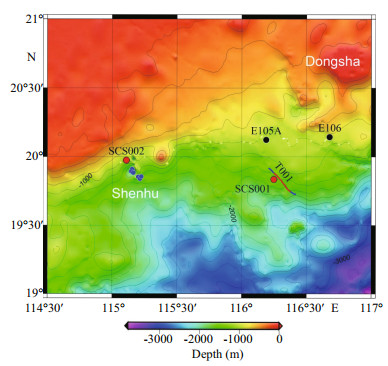
|
| Figure 1 Study area in the northern South China Sea The red dots show the measurement stations. The solid line shows the tow track, and the duration of methane anomalies is marked in red. The black dots show methane anomalies according to Yin et al. (2008), and the blue dots are China's first gas hydrate drilling sites according to Wu et al. (2007) and Li et al. (2010). |
The concentration of dissolve methane in the water column was measured in situ using a methane sensor. The methane sensor (METS) was manufactured by Franatech GmbH, Lüneberg, Germany. The sensor head consists of a silicone-rubber membrane, sintered metal disk, SnO2 semiconductor detector, and temperature detector (Fig. 2). The silicone-rubber membrane is semipermeable and allows gases to diffuse from the water and permeate through the porous metal into the detecting chamber based on the partial pressure gradient. The SnO2 and temperature detectors are used to detect the methane in the gas and the gas temperature, respectively. The measurement range of the METS sensor is 1–500 nmol/L. It can be used at temperatures in the range of 2–60℃ and at water depths less than 3 500 m. The METS was calibrated prior to the cruise, and the methane concentrations were calculated using the equation provided by the manufacturer.
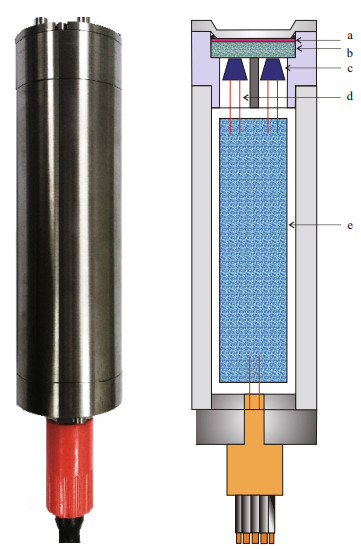
|
| Figure 2 METS sensor a. silicone-rubber membrane; b. sintered metal disk; c. SnO2 semiconductor detector; d. temperature detector; e. circuit board. |
The METS sensors were deployed at two vertical cast stations (SCS001 and SCS002) and towed along profile T001 (Fig. 1). For vertical cast stations, the METS sensor was attached to a coaxial cable 30 m above the TV-multicore sampler. For profile T001, the METS sensor was installed on a deep-towed TV-sled in combination with a pressure sensor. The sled was towed approximately 5 m above the seafloor at a speed of 1–2 knots. The frequency for data recording was set to 5 s.
3 RESULTProfile T001 was 30 km long, located in water depths between 1 270 and 1 675 m, in southwestern Dongsha. After the deployment of the TV-sled for 3 000 s, the equipment reached a location near the seafloor, and then it was towed along the profile ~5 m above the seafloor. Methane anomalies were then detected between 5 870 s and 38 295 s (Fig. 3). Figure 4 shows the variation of methane concentration with water depth. The methane concentration was elevated near the seafloor (water depths between 1 332 and 1 675 m). The maximum methane anomaly (3.8 nmol/L) appeared at a water depth of 1 500 m, about 2 times the background methane concentration.
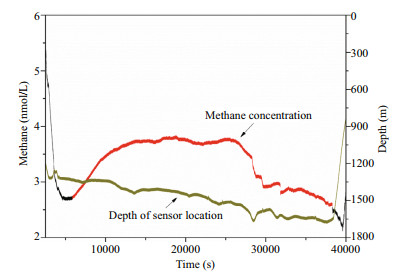
|
| Figure 3 Methane concentration vs. time for profile T001 in southwestern Dongsha The red line shows the period when the methane anomaly was detected. |
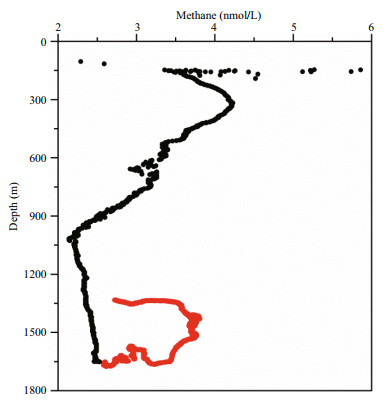
|
| Figure 4 Vertical concentration profiles of dissolved methane for profile T001 in southwestern Dongsha The red line indicates the elevated methane concentrations. |
Vertical casts were deployed at stations SCS001 and SCS002 to measure the methane concentration in the water column. No real-time water depth data were recorded in both vertical cast stations because no pressure sensor was integrated, but water depth can be determined from the temperature structure of the water column. Vertical cast station SCS001 was located at southwestern Dongsha, approximately 4 km away from profile T001, where the water depth is 1 440 m (Fig. 1). Figure 5 shows that after an elapsed time of 3 000 s, the METS sensor reached a location near the seafloor. Before the equipment reached the seafloor, the methane anomaly had already appeared for ~2 000 s. The maximum methane concentration detected was 8.8 nmol/L. Station SCS002 was located in the Shenhu area at a water depth of 1 171 m (Fig. 1). After 7 470 s, the METS sensor reached a location near the seafloor. Similarly to SCS001, methane anomalies appeared before the equipment reached the seafloor. Figure 6 shows that the maximum methane concentration detected was 10.1 nmol/L, which is the highest methane concentration detected among the 3 deployments.
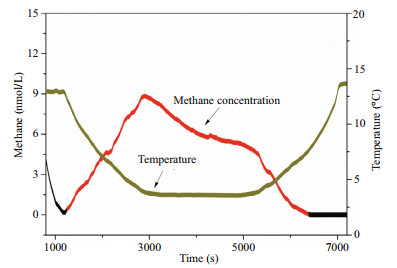
|
| Figure 5 Methane concentration vs. time for SCS001 in southwestern Dongsha The red line shows the period with methane anomalies. |
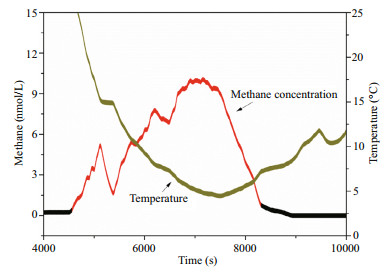
|
| Figure 6 Methane concentration vs. time for SCS002 in Shenhu The red line denotes the period with methane anomalies. |
Methane can only be generated in the mixed layer above the thermocline in the oceanic water column, where methane concentrations are generally 3.1– 5.0 nmol/L, in a moderately oversaturated state (Zhang and Zhang, 2001). The metabolism of planktons in the mixed layer is generally believed to be the main source of methane at high saturation (Traganza et al., 1979; Tilbrook and Karl, 1995). From the surface to the upper mixed layer, the methane concentration distribution is uniform, which is almost the same as that of the surface. At the bottom of the mixed layer, the methane concentration gradually increases and reaches an obvious maximum at the top of the thermocline. Below the thermocline depth, owing to lack of biological activity, the methane concentration decreases (Burke et al., 1983). At the same time, methane can be oxidized due to microbial activity in the water column (Ward et al., 1989). Therefore, the methane concentration of ocean water at the seafloor is generally lower and is approximately 0.5–2 nmol/L (Tilbrook and Karl, 1995; Kelley and Jeffrey, 2002). However, methane sources from beneath the seafloor can lead to anomalously high concentrations found in the ocean bottom water. These methane sources include the serpentinization of peridotite, gas hydrate decomposition, and leakage of offshore oil and gas reservoirs (Milkov, 2004; Reeburgh, 2007; Zhou et al., 2007). If there is external methane emission on seafloor, a methane plume can be detected (Sauter et al., 2006).
Along profile T001, methane concentration anomalies were continuously detected in the water column (1 332–1 675 m) for approximately 19 km. The maximum anomalous methane concentrations at T001 and SCS001 in southwestern Dongsha were 3.8 nmol/L and 8.8 nmol/L, respectively, whereas it reached up to 10.1 nmol/L at SCS002 in Shenhu at a water depth of 1 171 m (Table 1). These concentrations are significantly higher than the normal background methane concentrations of 0.5–2 nmol/L at the same water depth. Previously, Yin et al. (2008) used the cryo-trapping method to measure the methane concentrations of the water column at stations E105A and E106 in southwestern Dongsha and obtained anomalous methane concentrations of 4.25 nmol/L and 10.64 nmol/L at 979 m and 835 m, respectively (Fig. 1; Table 1). Zhou et al. (2009) reported that an anomalous methane concentration of 4.3 nmol/L was measured at a water depth of 900 m at station B8 located in southwestern Dongsha (Table 1). The results from this study further support that there are methane plumes rising from seafloor in the southwestern Dongsha and Shenhu areas. The range of water depth affected by methane seepage is approximately 800–1 700 m.

|
Abundant geophysical and geological evidence suggests that there are gas hydrates present beneath the seafloor in the Shenhu and Dongsha areas (Huang et al., 2005; Yao, 2007; Shang et al., 2008). The seep carbonate chimneys, crusts, and chemoherms with depleted 13C and enriched 18Ocompositions discovered in the Shenhu and Dongsha areas indicate that methane seepages have been active in the past, and the formation of seep carbonates has been associated with gas hydrate decomposition (Lu et al., 2006; Han et al., 2008, 2013, 2014). Recently, gas hydrate samples obtained by drilling further confirmed the presence of gas hydrate deposits (Wu et al., 2007; Zhang et al., 2014). Although no active venting site has been observed in the two areas, the methane anomalies detected in this study indicate that active methane venting sites are likely present in the investigation area. More detailed surveys would be needed to precisely locate these venting sites.
5 CONCLUSIONA methane sensor was used to measure the methane concentrations of the water column on the northeastern continental slope of the South China Sea. A methane plume was detected at a water depth of 1 332–1 675 m along profile T001 and at station SCS001 in the southwestern Dongsha area, where the maximum methane concentration was 3.8 nmol/L and 8.8 nmol/L, respectively. The thickness of the plume was 343 m. At station SCS002 in the Shenhu area, the methane concentrations were even higher (CH4 Max= 10.1 nmol/L, water depth 1 171 m). Therefore, active methane venting sites likely exist in the investigation areas, and in situ methane measurements using a methane sensor can trace the methane venting sites and monitor the methane leakages from the seafloor efficiently.
6 DATA AVAILABILITY STATEMENTThe data that support the findings of this study are available from the corresponding author upon reasonable request.
7 ACKNOWLEDGEMENTThe authors appreciate the assistance of all cruise members on the RV/Dayangyihao during the DY 21 cruise. Thanks to Akiningbagbe Akintoye Edward, and Enago (www.enago.cn), for English language editing. We thank Anika Burkard Newell, PhD, from Edanz Group (www.edanzediting.com/ac) for editing a draft of this manuscript.
Burke Jr R A, Reid D F, Brooks J M, Lavoie D M. 1983. Upper water column methane geochemistry in the eastern tropical North Pacific. Limnology and Oceanography, 28(1): 19-32.
DOI:10.4319/lo.1983.28.1.0019 |
Han X Q, Suess E, Huang Y Y, Wu N Y, Bohrmann G, Su X, Eisenhauer A, Rehder G, Fang Y X. 2008. Jiulong Methane Reef:Microbial mediation of seep carbonates in the South China Sea. Marine Geology, 249(3-4): 243-256.
DOI:10.1016/j.margeo.2007.11.012 |
Han X Q, Suess E, Liebetrau V, Eisenhauer A, Huang Y Y. 2014. Past methane release events and environmental conditions at the upper continental slope of the South China Sea:constraints by seep carbonates. International Journal of Earth Sciences, 103(7): 1.
|
Han X Q, Yang K H, Huang Y Y. 2013. Origin and nature of cold seep in northeastern Dongsha area, South China Sea:Evidence from chimney-like seep carbonates. Science Bulletin, 58(30): 3 689-3 697.
DOI:10.1007/s11434-013-5819-x |
Huang Y Y, Suess E, Wu N Y. 2005. Geological setting and evidences of gas hydrate occurring in the North-east Dongsha area of South China Sea. Proceedings of Gas Hydrate Colloquium between Taiwan and Motherland, Tainan: p.3-4.
(in Chinese with English abstract) |
Kelley C A, Jeffrey W H. 2002. Dissolved methane concentration profiles and air-sea fluxes from 41°S to 27°N. Global Biogeochemical Cycles, 16(3): 13-1-13-6.
|
Kvenvolden K A. 1993. Gas hydrates-geological perspective and global change. Reviews Geophysics, 31(2): 173-187.
DOI:10.1029/93RG00268 |
Li S J, Chu F Y, Fang Y X, Wu Z Y, Ni Y G. 2010. Associated interpretation of sub-bottom and single-channel seismic profiles from slope of Shenhu Area in the northern South China Sea-characteristics of gas hydrate sediment. Journal of Tropical Oceanography, 29(4): 56-62.
(in Chinese with English abstract) |
Lu H F, Chen F, Liu J, Liao Z L, Sun X M, Su X. 2006. Characteristics of authigenic carbonate chimneys in Shenhu area, northern South China Sea:recorders of hydrocarbon-enriched fluid activity. Geological Review, 52(3): 352-357.
(in Chinese with English abstract) |
McInerney F A, Wing S L. 2011. The paleocene-eocene thermal maximum:a perturbation of carbon cycle, climate, and biosphere with implications for the future. Annual Review of Earth & Planetary Sciences, 39(11): 489-516.
|
Milkov A V. 2004. Global estimates of hydrate-bound gas in marine sediments:how much is really out there?. EarthScience Reviews, 66(3-4): 183-197.
|
Reeburgh W S. 2007. Oceanic methane biogeochemistry. Chemical Reviews, 107(2): 486-513.
DOI:10.1021/cr050362v |
Ruppel C D, Kessler J D. 2017. The interaction of climate change and methane hydrates. Reviews of Geophysics, 55(1): 126-168.
DOI:10.1002/rog.v55.1 |
Sauter E J, Muyakshin S I, Charlou J L, Schlüter M, Boetius A, Jerosch K, Damm E, Foucher J P, Klages M. 2006. Methane discharge from a deep-sea submarine mud volcano into the upper water column by gas hydratecoated methane bubbles. Earth and Planetary Science Letters, 243(3-4): 354-365.
DOI:10.1016/j.epsl.2006.01.041 |
Shang J H, Li J B, Zhang J B. 2008. Contrast of seismic reflection characteristics of gas hydrate distribution between northeast SCS slope and Hengchun ridge. Marine Science Bulletin, 10(1): 64-74.
|
Tilbrook B D, Karl D M. 1995. Methane sources, distributions and sinks from California coastal waters to the oligotrophic North Pacific gyre. Marine Chemistry, 49(1): 51-64.
DOI:10.1016/0304-4203(94)00058-L |
Traganza E D, Swinnerton J W, Cheek C H. 1979. Methane supersaturation and ATP-zooplankton blooms in nearsurface waters of the Western Mediterranean and the subtropical North Atlantic Ocean. Deep Sea Research Part A. Oceanographic Research Papers, 26(11): 1 237-1 245.
DOI:10.1016/0198-0149(79)90066-9 |
Ward B B, Kilpatrick K A, Wopat A E, Minnich E C, Lidstrom M E. 1989. Methane oxidation in Saanich inlet during summer stratification. Continental Shelf Research, 9(1): 65-75.
DOI:10.1016/0278-4343(89)90083-6 |
Wu N Y, Zhang H Q, Yang S X, Liang J Q, Wang H B. 2007. Preliminary discussion on natural gas hydrate (NGH) reservoir system of Shenhu area, north slope of South China Sea. Natural Gas Industry, 27(9): 1-6.
(in Chinese with English abstract) |
Yao B C. 2007. The forming condition and distribution characteristics of the gas hydrate in the South China Sea. Offshore Oil, 27(1): 1-10.
(in Chinese with English abstract) |
Yin X J, Zhou H Y, Yang Q H, Wang H, Chen J. 2008. The evidence for the existence of methane seepages in the northern South China Sea:abnormal high methane concentrations in bottom waters. Acta Oceanologica Sinica, 27(6): 62-70.
|
Zhang G L, Zhang J. 2001. Advances in studies of dissolved methane in seawater. Advance in earth Sciences, 16(6): 829-835.
(in Chinese with English abstract) |
Zhang G X, Yang S X, Zhang M, Liang J Q, Lu J G, Holland M, Schultheiss P, the GMGS2 ScienceTeam. 2014. GMGS2 expedition investigates rich and complex gas hydrate environment in the South China Sea. Methane Hydrate Newsletter, 14(1): 1-5.
|
Zhou H Y, Wu Z J, Peng X T, Jiang L, Tang S. 2007. Detection of methane plumes in the water column of Logatchev hydrothermal vent field, Mid-Atlantic Ridge. Chinese Science Bulletin, 52(15): 2 140-2 146.
|
Zhou H Y, Yin X J, Yang Q H, Wang H, Wu Z J, Bao S X. 2009. Distribution, source and flux of methane in the western Pearl River Estuary and northern South China Sea. Marine Chemistry, 117(1-4): 21-31.
DOI:10.1016/j.marchem.2009.07.011 |
 2018, Vol. 36
2018, Vol. 36


